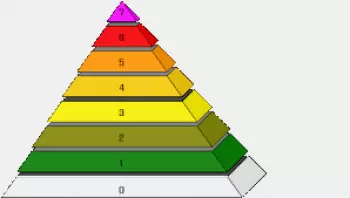
The INES scale is a tool to quantify the severity of a nuclear and radiological event (whether atomic accidents or incidents). INES stands for International Nuclear Events Scale.
The radiological event scale INES is used for prompt communication of safety significance to the world about any nuclear accident.
This scale explains the safety significance of events from a range of nuclear activities. These activities may include:
-
Medical and industrial use of radiation sources
-
Transport of radioactive material
-
Operations in nuclear power plants or other facilities.
The international nuclear and radiological event scale ranks the events in seven levels.
We call incidents the events ranked within the levels from one to three. On the other hand, we call accidents when four or higher.
Each level ascent on the scale indicates that the severity of the events is about ten times greater.
Nuclear energy events are classified by the following levels:
Level 7: Serious accident
Level 7 of the INES scale is the major level at which an event can be ranked.
This level implies the severe release of radioactive materials with extensive effects on health and the environment. Therefore, we need far-reaching emergency measures to control such a disaster. According to the International Atomic Energy Agency (IAEA), an accident is ranked at level 7 is when the total emissions reach a few tens of thousands of tera becquerels (TBq).
So far, there have been two accidents ranked with this level at two nuclear power plants:
-
The Chernobyl accident of April 26, 1986. It was the worst nuclear disaster in history. The disaster occurred in the URSS while the plant was carrying on a planned test. An enchained sequence of human mistakes led the reactor to collapse.
-
The Fukushima Daiichi nuclear disaster of March 11, 2011, in Japan. It was due to the consequences of a severe earthquake followed by a tsunami that damaged the plant’s vital elements.
Level 6: Major Accident
An ample amount of radioactive material is released, and planned emergency measures are likely to be implemented.
Level 6 events have life consequences because the amount of radioactive material released directly influences the living environment.
The Mayak nuclear accident near Kyshtym (Russia) is the only disaster classified at this level. The accident occurred at a nuclear fuel reprocessing plant, and around 2 · 1017 becquerels of radioactivity were released.
Level 5: Accident with far-reaching consequences
A level 5 nuclear event involves the limited release of radioactive materials in terms of people and the environment. This release may require the use of some of the anticipated countermeasures.
At level 5, several deaths from radiation can already occur.
This type of nuclear accident involves severe damage to the nuclear reactor core.
It entails the release of large quantities of radioactive materials within a facility. Therefore, it has a high chance of public exposure and can be caused by fire or a critical accident.
In history, there has been 4 level 5 accidents:
-
Fire at Windscale Piles (UK)
-
Three Mile Island Nuclear Power Plant (USA)
-
Accident at two nuclear reactors in Chalk River (Canada)
-
Radioactive emission in Goiânia (Brazil)
Level 4: Accident with local consequences
A level 4 nuclear accident involves the minor release of radioactive materials. The release has little chance of applying the anticipated countermeasures, except for local food controls. It also involves at least one radiation death.
If the nuclear fuel has been damaged with a release higher than the 0.1% of the inventory, it will be ranked in this category. Level 4 would also include releasing significant amounts of radioactive material. It has a high probability of significant public exposure.
The most prominent level 4 nuclear accidents to date are the following:
-
Sellafield (UK) - five incidents from 1955 to 1979.
-
SL-1 Experimental Power Plant (United States) - 1961
-
Saint-Laurent nuclear power plant (France) - 1969.
-
Buenos Aires (Argentina) - 1983, criticality accident in the RA-2 research reactor
-
The Tokaimura nuclear accident (Japan) - 1999.
-
Mayapuri (India) - 2010.
Level 3: Major Incident
Main characteristics of the level 3 incidents of the INES scale:
-
Exposure is ten times higher than the annual limit established for worker exposure.
-
Non-lethal effect of radiation on health (e.g., burns).
-
Exposure rates are more significant than 1 Sv / h in an operating area.
-
Severe contamination in an area not foreseen in the design, with few odds of significant public exposure.
Level 2: Incident
Main features:
-
Exposure of a person from the public above ten mSv.
-
Exposure of a worker above the annual regulatory limits.
-
Radiation levels are greater than 50 mSv / h in an operating area.
-
Significant contamination within a facility in an area not anticipated in the design.
-
Major failures in the safety provisions, but without real consequences.
-
It can happen while finding an orphan sealed source, device, or high radioactivity transport packaging, with safety provisions, without impairment.
-
Improper packaging of a sealed source of high radioactivity.
Level 1: Anomaly
An anomaly is a minimal nuclear incident. At this level, only the defense-in-depth aspect. It is then about the exposure of one or more citizens to radiation doses above the allowed limits.
This level implies minor problems with the security systems with enough redundant systems left.
An anomaly involves:
-
The exposure that a person receives is higher than the annual regulatory limits.
-
Minor problems in security components, with critical defense-in-depth measures pending implementation.
-
Loss or theft of radioactive sources, devices, or low-activity transportation packaging.
Level 0: without significance
The events without safety significance are classified Below Scale / Level 0, called “deviations.”



